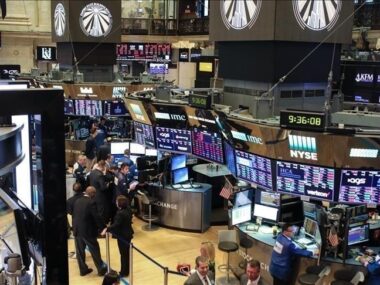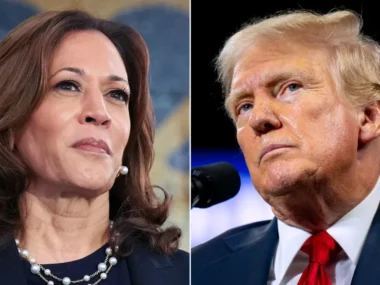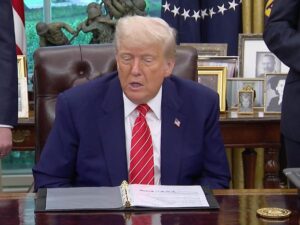Despite President Donald Trump pausing his massive tariff increase on several countries, Americans remain concerned about a potential recession and rising inflation.
According to the University of Michigan’s latest survey, consumer sentiment fell by 8% in April, reaching a final score of 52.2. This was a smaller drop than an earlier preliminary reading, which did not reflect reactions to Trump’s April 9 announcement of a 90-day tariff delay.
April’s sentiment score marked the fourth-lowest on record since 1952.
Joanne Hsu, the survey’s director, explained that the decline was especially pronounced among middle-income families, with sentiment worsening across various age, education, income, and political groups. “Consumers are worried about multiple areas of the economy, largely due to ongoing trade policy uncertainty and the possibility of renewed inflation,” Hsu said in a release.
Stocks briefly recovered as investors processed the survey results: the Dow was down by 200 points (0.5%), the S&P 500 dropped 0.15%, and the Nasdaq Composite rose by 0.1%.
Trump’s unpredictable trade policies have affected Americans’ economic outlook in recent months. Now, both the Federal Reserve and Wall Street are closely monitoring whether this will lead to more cautious consumer spending, which could dampen economic growth or even trigger a recession. Given that consumer spending drives most of the U.S. economy, a slowdown in spending could significantly impact overall economic performance.
Focus shifts to consumer spending.
While U.S. consumers are clearly feeling anxious, it’s uncertain how this will impact their spending.
In June 2022, when inflation hit a 40-year high, consumer sentiment dropped to an all-time low, yet spending continued in the months that followed. Similarly, in 2023, despite a congressional standoff over the debt ceiling, Americans’ economic outlook worsened, but they still spent on travel and concerts. During both years, economic growth and the labor market remained strong.
“Surveys can be quite negative, but people still keep spending,” said Federal Reserve Chair Jerome Powell earlier this month. However, today’s economy differs from 2022. The job market isn’t as strong, consumers have largely depleted pandemic-era savings, and the Department of Education recently announced it will restart the collection of federal student loans in default, ending a pause that had been in place for about five years.
Additionally, the latest quarterly survey on household finances from the New York Fed shows that consumers were more financially strained toward the end of last year.
Economists note that assessing the true health of consumer spending has been challenging due to temporary economic factors, such as people accelerating big-ticket purchases to avoid tariffs, which caused a spike in retail sales in March.
Still, as long as unemployment stays low and layoffs remain minimal, consumer spending is expected to continue.
Waiting for clarity
The ongoing uncertainty about Trump’s policies is also troubling central bankers responsible for setting interest rates, impacting costs on everything from mortgages to credit cards.
Trump’s tariffs are expected to increase inflation, but economists disagree on how severe or long-lasting this effect will be. This is a key factor that Federal Reserve officials are considering as they prepare for future actions once tariff effects appear in economic data.
“We can’t say with confidence right now: Is this a short-term impact on inflation, or something longer-lasting?” said Minneapolis Fed President Neel Kashkari during an event in Washington. “Our role at the Fed is to ensure it doesn’t become a long-term issue.” A crucial indicator for Fed policymakers is people’s perception of prices, as it can become self-fulfilling. If people anticipate rising inflation, they might adjust their spending accordingly. Although inflation expectations for the next year were slightly lower in the University of Michigan’s final consumer sentiment report compared to the preliminary one, they still reached their highest point since 1981.
For the time being, however, Fed officials are taking a wait-and-see approach to gauge how the US economy responds to the administration’s significant policy changes.
Trump’s policies have already shown effects in survey-based data, such as the University of Michigan’s consumer sentiment report. However, no major issues have yet emerged in “hard data,” which reflects actual economic activity.
Most Fed officials are closely monitoring any potential economic fallout from Trump’s policies, which, alongside tariffs, include mass deportations and deregulation.
“It’s crucial for monetary policymakers to examine all available information, including market-based measures, surveys, and anecdotal reports, to understand economic trends as soon as possible because policy effects take time,” said Fed Governor Adriana Kugler during an event in Minneapolis.











